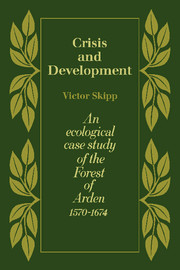Book contents
3 - The ecological approach
Published online by Cambridge University Press: 05 November 2011
Summary
The main demographic, economic and social changes which took place in the five north Arden parishes during late Tudor and early Stuart times were described in a paper contributed to the H. P. R. Finberg Festschrift of 1970. In the 1570s the combined population of the five communities was probably about 2,2 50 (Table X, p. 116). By 1650 there had been something like a 50% increase, to about 3,400. Meanwhile, on the economic front convertible husbandry had been introduced: so that it had become ‘a usual course with the inhabitants to plow their ground which they doe call pasture for twoe or three yeares together, and then lett it lye for pasture fifteene or twenty yeares and then plowe it againe’. An equally important economic development was the marked expansion of industrial activity. In the mid Tudor period such craftsmen as were to be found were invariably farmer or smallholder craftsmen who pursued their weaving, tanning, tile-making and smithery as a part-time by-employment. By the mid seventeenth century their successors had been joined, and indeed largely superseded, by a growing body of full-time landless craftsmen. With regard to social structure, the 1970 article demonstrated that, as a result of the price rise, the food-producing landed peasantry – small husbandmen as well as substantial yeomen – became increasingly prosperous; and here, as elsewhere, were able to indulge in the familiar spate of house improvement and refurnishing. But the effects of the price rise on the landless cottagers was the exact reverse, and by the 1660s 40% of local populations were adjudged too poor to pay the hearth tax.
- Type
- Chapter
- Information
- Crisis and DevelopmentAn Ecological Case Study of the Forest of Arden 1570–1674, pp. 9 - 10Publisher: Cambridge University PressPrint publication year: 1978



